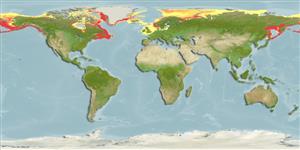分類 / Names
俗名 | 同種異名 | Catalog of Fishes(屬, 種) | ITIS | CoL | WoRMS | Cloffa
Teleostei >
Perciformes/Zoarcoidei (Eelpouts and pricklebacks) >
Lumpenidae (Eel pricklebacks)
Etymology: Leptoclinus: Greek, leptos = thin + Greek, klinein, kline = sloping and bed, due to the four apophyses of sphenoid bone (Ref. 45335).
Environment: milieu / climate zone / depth range / distribution range
生態學
海洋 居於水底的; 深度上下限 2 - 607 m (Ref. 58426). 極; -2°C - 2°C (Ref. 120227); 79°N - 43°N, 180°W - 180°E (Ref. 86838)
Circumpolar: Arctic to temperate waters; northern hemisphere. Arctic Alaska to Sea of Okhotsk, northern Sea of Japan, Unalaska Island in the Aleutian chain and Puget Sound, Washington, USA. North Atlantic: Arctic to Labrador in Canada; along Scandinavia from Skagerrak to Finnmarken, common at Murmansk, White Sea, Iceland and Greenland (Ref. 10006). The Pacific form is sometimes treated as a subspecies Leptoclinus maculatus diaphanocarus (Ref. 51666).
Circumglobal: 北極圈到溫帶水域; 北半球。 阿拉斯加到北極圈鄂霍次克海,日本海北部, 在 Aleutian 的 Unalaska 島用鐵鍊鎖住,而且 Puget 聽, 美國在華盛頓州。 北大西洋: 在加拿大的北極圈到拉布拉多; 沿著從史卡基拉克海域到 Finnmarken 的斯堪那維亞半島,普遍於莫曼斯克,白海,冰島與格陵蘭.(參考文獻 10006) 太平洋型式有時被視為一個亞種 斑細鳚〔Leptoclinus maculatus〕 diaphanocarus 。 (參考文獻 51666)
Length at first maturity / 大小 / 重量 / 年齡
Maturity: Lm 12.5, range 13 - 13 cm
Max length : 20.0 cm TL 雄魚/尚未辨別雌雄; (Ref. 35388)
背棘 (總數) : 57 - 60; 背的軟條 (總數) : 0; 臀棘: 1 - 2; 臀鰭軟條: 34 - 36. Caudal rounded; lower 5 rays of pectorals greatly lengthened and exserted (Ref. 6885). Color greyish - yellow with dark irregular spots (Ref. 35388).
尾鰭圓的; 胸鰭的低 5個鰭條非常加長了而且突出的。 (參考文獻 6885) 色彩灰黃色的有深色的不規則的斑點.(參考文獻 35388)
Adults, juveniles, and late postlarvae are found on sandy and mud to pebble bottoms, usually in less than 170 meters (Ref. 2850, 51666, 120227), while early postlarvae are pelagic (Ref. 120227). Food consists of polychaetes and crustaceans (Ref. 10571). They are an important prey for pelagic (as larvae) and benthic (as adults) predators (Ref. 120226). Sexual dimorphism is more pronounced after maturation with males displaying faster somatic growth (Ref. 120226). This marked dimorphism may well be linked with behavioral dissimilarities between males and
females, and is most likely associated with different roles during the breeding season with only adult males have large canines at the tip of upper jaw. It is assumed that males are territorial and defend their spawning sites, whereasfemales guard eggs within her partner’s territory (Ref. 128434).
棲息於砂質底部;(參考文獻 2850) 泥到小圓石底部, 通常在少於 170 公尺。 (參考文獻 51666) 底棲的.(參考文獻 58426) 吃多毛類動物與甲殼動物。 (參考文獻 10571)
Life cycle and mating behavior
成熟度 | 繁殖 | 產卵場 | 卵 | 孕卵數 | 仔魚
Males exhibit territorial defence (Ref. 120226).Circumglobal: 北極圈到溫帶水域; 北半球。 阿拉斯加到北極圈鄂霍次克海,日本海北部, 在 Aleutian 的 Unalaska 島用鐵鍊鎖住,而且 Puget 聽, 美國在華盛頓州。 北大西洋: 在加拿大的北極圈到拉布拉多; 沿著從史卡基拉克海域到 Finnmarken 的斯堪那維亞半島,普遍於莫曼斯克,白海,冰島與格陵蘭.(參考文獻 10006) 太平洋型式有時被視為一個亞種 斑細鳚〔Leptoclinus maculatus〕 diaphanocarus 。 (參考文獻 51666)
Eschmeyer, W.N., E.S. Herald and H. Hammann, 1983. A field guide to Pacific coast fishes of North America. Boston (MA, USA): Houghton Mifflin Company. xii+336 p. (Ref. 2850)
IUCN 瀕危狀態 (Ref. 130435: Version 2024-2)
人類使用
漁業:
工具
特別的報告
下載 XML
網路資源
Estimates based on models
Preferred temperature (Ref.
123201): 0.2 - 7, mean 2.3 °C (based on 1058 cells).
Phylogenetic diversity index (Ref.
82804): PD
50 = 1.0000 [Uniqueness, from 0.5 = low to 2.0 = high].
Bayesian length-weight: a=0.00363 (0.00151 - 0.00871), b=2.95 (2.74 - 3.16), in cm total length, based on LWR estimates for this (Sub)family-body shape (Ref.
93245).
營養階層 (Ref.
69278): 3.3 ±0.39 se; based on food items.
Generation time: 11.1 ( na - na) years. Estimated as median ln(3)/K based on 2
growth studies.
回復力 (Ref.
120179): 低的, 最小族群倍增時間4.5 - 14 年 (tm=7; tmax=12; K=0.099; Fec=931).
Fishing Vulnerability (Ref.
59153): High vulnerability (59 of 100).
Nutrients (Ref.
124155): Calcium = 22.3 [4.8, 93.2] mg/100g; Iron = 0.512 [0.172, 1.359] mg/100g; Protein = 16.8 [14.9, 18.9] %; Omega3 = 0.288 [0.112, 0.751] g/100g; Selenium = 9.62 [3.01, 35.80] μg/100g; VitaminA = 35.4 [6.5, 194.5] μg/100g; Zinc = 0.57 [0.29, 1.21] mg/100g (wet weight);
